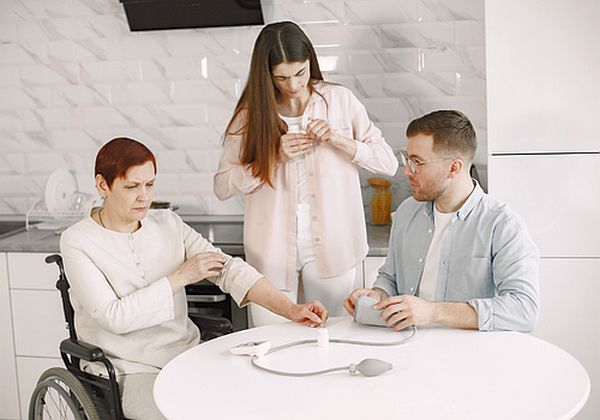High Blood Pressure & Women
It’s a peculiar paradox.
Women make up over half of the deaths caused by high blood pressure. 52%, to be precise. Yet the common cardiovascular condition is often considered a significant health risk for men.
Misconceptions aside, what are the key things to know about high blood pressure and women? How do hormones and life cycle events have an impact?
Let’s dive in.
Why Does High Blood Pressure Cause 1 in 5 Deaths Among Women?
The National Library of Medicine explains that 20% of deaths among women in the U.S. are due to high blood pressure (hypertension). A surprising statistic, right?
It’s true that men have a greater incidence of high blood pressure than women (55% compared with 44%). But the consequences of hypertension in females are more severe.
Reason being?
The exact reasons are not evident. Nevertheless, here are a couple of the essential findings to be aware of:
According to a study published in the JAMA Cardiology, blood pressure advances faster in women. The Smidt Heart Institute gathered data over 43 years and more than 140,000 blood pressure measurements. They discovered that women’s blood vessels show signs of aging more quickly than men’s. The senior author of the study – Susan Cheng, MD, MPH, MMSc – gave further context to these findings:

“Our data showed that rates of accelerating blood pressure elevation were significantly higher in women than men, starting earlier in life…. a 30-year old woman with high blood pressure is probably at higher risk for cardiovascular disease than a man with high blood pressure at the same age.”
Women with hypertension are more likely to develop a range of other health issues. This includes arterial stiffness, chronic kidney disease, diabetes, and heart failure.
The prevalence of hypertension in women increases with age. See below for how the genders compare by age category:
- Age 20-34: 11% of men, 8% of women
- Age 35-44: 23% of men, 23% of women
- Age 45-54: 36% of men, 33% of women
- Age 55-64: 58% of men, 56% of women
- Age 65-74: 64% of men, 66% of women
- Age 75+: 73% of men, 81% of women
Blood pressure by Age
| Blood Pressure by Age | ||
| Men | Women | |
| 18 – 39 years | 119/70 mm Hg | 110/68 mm Hg |
| 40 – 59 years | 124/77 mm Hg | 122/74 mm Hg |
| 60+ years | 133/69 mm Hg | 139/68 mm Hg |
Source: Blood Pressure Chart With Readings By Age and Sex, verywellhealth.com
How Does Menopause Affect Blood Pressure?
Scientific research shows an association between menopause and hypertension. Genes are a significant factor here, accounting for as much as 50% of the variation in postmenopausal blood pressure levels.
Changes in hormones may also cause weight gain during and after menopause. This can make women more sensitive to dietary salt intake, which is one of the core drivers of hypertension.
High Blood Pressure and Women: 6 Tips to Tackle Hypertension
Want to be proactive and limit your risk of developing hypertension? Or, perhaps you have high blood pressure and need to do all you can to bring it down?
You’ll give yourself a better chance by following these six tips:
- Cut down on salt and refined sugars.
- Try to exercise daily to your tolerance level. Walking, jogging, swimming, weightlifting, and yoga can all help.
- Refer to the body mass index calculator (BMI) and aim to weigh in the healthy range for your height.
- Review any medications you’re taking with your doctor, in case these may contribute to raised blood pressure.
- Avoid smoking and frequent alcohol consumption.
- Measure your blood pressure regularly at home. Try to do so at different times of the day. Remember, readings taken at a clinic often aren’t representative. This can be due to raised levels of activity, as well as the stress of having your blood pressure measured while a nurse or doctor is watching on.

Finding At-Home Blood Pressure Measurements a Hassle? Do This Instead
Need to check your blood pressure more often than before?
You may have the best intentions. But the busyness and distractions of real life have other ideas. In reality, it’s not easy to find the time to get the monitor and cuff out and take multiple measurements per day.
Is there a more practical alternative?
There sure is!
Have a look at Aktiia – the smartest blood pressure measuring tool on the market.

Clinically supported for its accuracy and safety, the Aktiia bracelet allows you to monitor your blood pressure 24/7 while you go about your day (and night!) as you please.
No more constantly having to put on the cuff.
No more basing important health decisions on faulty or sporadic measurements.
See if Aktiia is right for you.
Not sure just yet? You can keep up to date by subscribing to the Aktiia Newsletter:
Disclaimer: This article provides educational information about hypertension in women and is not intended as medical advice. Always consult your physician or qualified healthcare provider for any questions related to a medical condition. Any changes to your healthcare should be made under medical supervision. The author and publisher are not responsible for any adverse effects resulting from the use or application of the information presented in this article.
Sources
Blood Pressure Chart With Readings By Age and Sex, October 2022 – https://www.verywellhealth.com/average-blood-pressure-by-age
Hypertension Across a Woman’s Life Cycle, April 24, 2018 – https://www.ncbi.nlm.nih.gov/articles-PMC6005390
Facts About Hypertension, January 5, 2023 – https://www.cdc.gov/bloodpressure-facts
Women’s Blood Vessels Age Faster Than Men’s, January 15, 2020 – https://https://www.cedars-sinai.org/study-womens-blood-vessels-age-faster-than-mens
Hypertension in Women, May 8, 2017 – https://www.ahajournals.org/HYPERTENSIONAHA
Hypertension Across a Woman’s Life Cycle, April 24, 2018 – https://www.ncbi.nlm.nih.gov/articles-PMC6005390


